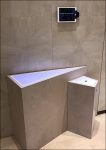
Rebecca Minkoff uses RFID technology to provide self-service for its stores
[ad_1]
Rebecca Minkoff, a retailer of luxury handbags and accessories, began trialing an RFID self-checkout system in New York stores to help consumers pay on iPads and unlock security tags so that consumers don’t have to wait in line to pay. The solution is provided by the start-up QueueHop. The self-checkout unit in this solution uses an RFID interrogator to read product hard tags, an iPad is installed on the wall for consumers to pay, and another RFID card reader is used to read the hard tags in the slot. In this way, the tag can be removed after payment.
Rebecca Minkoff has been using RFID technology to enhance the store experience. The fitting room of the “Future Store” located on 96 Greene Street is equipped with RFID magic mirrors to identify the clothing being tried on and provide recommendations for its purchase. The company’s CEO and founder Uri Minkoff said: “We have two expectations for this store of the future. Provide a celebrity VIP experience (such as customized purchase advice); provide a private, almost anonymous experience.”

(The self-checkout unit is equipped with an RFID reader, which can be used to read the hard tags of each product)
QueueHop technology enables private and anonymous sales, and consumers no longer need to wait in line at the cashier. The store has attached hard tags with built-in EAS technology and UHF RFID tags to hundreds of handbags, scarves and small leather products. The company’s long-term goal is to use the technology in other Minkoff products.
The company’s CEO and co-founder Lindon Gao said that at the beginning of this year, QueueHop launched RFID hard tags. The nightmare experience of long lines to check out gave birth to the development of this product.
Gao added that millennials prefer to use smartphones for consumption. For retailers, the problem is the security label, they need some way to provide security to ensure that the goods will not leave the store without payment. However, the removal of hard tags in the past required the involvement of store staff, which also meant queuing.
In addition, in stores like Rebecca Minkoff, some customers are very concerned about privacy. Minkoff hopes that every customer can shop in a relaxed environment. In some cases, this means that there is no need to communicate with staff during the purchase process.
QueueHop’s RFID hard tag has a built-in UHF chip and a pin to lock the tag. Gao produced the card reader himself, using chips provided by multiple manufacturers.
A tablet computer is installed in the Rebecca Minkoff store to display the QueueHop application. The tablet computer is mounted on a wall with two RFID readers. When consumers approach the self-checkout station, they need to place the items they want to buy near the tablet computer. The 2 nearby RFID readers will read the RFID tag in the hard tag and transmit the data to the QueueHop application. Then, the consumer can make the payment on the tablet, and after the payment is completed, the software will update the item status to “sold”.
After the purchase, consumers should use a second card reader to read the tag to unlock it. If the item status is “Sold”, the mechanical lock in the hard tag will be automatically unlocked. In this way, consumers can remove the hard label and take the item away from the store.
Minkoff is satisfied with the performance of the technology so far. He said: “We like this technology very much and will further test the system after the Christmas shopping season in the future.”
Currently, stores are using QueueHop hard tags to provide more security than ordinary EPC UHF tags. For ordinary EPC UHF tags, the thief can use the body to block the tag transmission to carry out theft. Using RFID and EAS technology, stores can provide security and privacy.
QueueHop also provides its application-based solutions that allow customers to make payments using smartphones. In this case, the user only needs to scan the QR code on the product label to use the mobile phone to pay. The store will unlock the station for the user to remove the hard tag. Once the QueueHop system confirms that the item has indeed been purchased, the user can remove the tag by themselves.
(Exclusive manuscript of rfid world network, please indicate the source author for reprinting!)
[ad_2]






